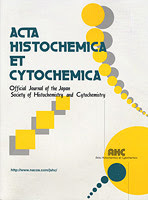 Acta Histochemica et Cytochemica, an Official Journal of the Japan Society of Histochemistry and Cytochemistry, published our review on quantitative colocalization analysis. The review is entitled "Quantitative colocalization analysis of multicolor confocal immunofluorescence microscopy images: pushing pixels to explore biological phenomena" (Acta Histochem Cytochem 2007 40:101-111). This is the most comprehensive review on this subject available. It should be very helpful to the beginners and to those familiar with the technique alike, as it not only gives the basics of the colocalization theory, but provides examples of the practical use of quantitative colocalization analysis as well.
Acta Histochemica et Cytochemica, an Official Journal of the Japan Society of Histochemistry and Cytochemistry, published our review on quantitative colocalization analysis. The review is entitled "Quantitative colocalization analysis of multicolor confocal immunofluorescence microscopy images: pushing pixels to explore biological phenomena" (Acta Histochem Cytochem 2007 40:101-111). This is the most comprehensive review on this subject available. It should be very helpful to the beginners and to those familiar with the technique alike, as it not only gives the basics of the colocalization theory, but provides examples of the practical use of quantitative colocalization analysis as well.
Monday, November 26, 2007
Review on quantitative colocalization analysis
 Acta Histochemica et Cytochemica, an Official Journal of the Japan Society of Histochemistry and Cytochemistry, published our review on quantitative colocalization analysis. The review is entitled "Quantitative colocalization analysis of multicolor confocal immunofluorescence microscopy images: pushing pixels to explore biological phenomena" (Acta Histochem Cytochem 2007 40:101-111). This is the most comprehensive review on this subject available. It should be very helpful to the beginners and to those familiar with the technique alike, as it not only gives the basics of the colocalization theory, but provides examples of the practical use of quantitative colocalization analysis as well.
Acta Histochemica et Cytochemica, an Official Journal of the Japan Society of Histochemistry and Cytochemistry, published our review on quantitative colocalization analysis. The review is entitled "Quantitative colocalization analysis of multicolor confocal immunofluorescence microscopy images: pushing pixels to explore biological phenomena" (Acta Histochem Cytochem 2007 40:101-111). This is the most comprehensive review on this subject available. It should be very helpful to the beginners and to those familiar with the technique alike, as it not only gives the basics of the colocalization theory, but provides examples of the practical use of quantitative colocalization analysis as well.
Wednesday, November 21, 2007
Interesting paper appeared in Journal of Clinical Investigation
 Journal of Clinical Investigation (Impact Factor 16 in 2006), published a very interesting paper about requirement of Foxo3 (forkhead box O3) for the regulation of oxidative stress in erythropoiesis (J. Clin. Invest. 117:2133-2144 (2007). The study is a collaborative effort performed by Dr D Marinkovic and colleagues from Departments of Gene and Cell Medicine, Mount Sinai School of Medicine, New York, USA, Laboratory Medicine, Children’s Hospital, Harvard Medical School, Boston, Massachusetts, USA, Black Family Stem Cell Institute, and Departments of Molecular, Cell, and Developmental Biology, and Medicine, Division of Hematology and Medical Oncology, Mount Sinai School of Medicine, New York, New York, USA.
Journal of Clinical Investigation (Impact Factor 16 in 2006), published a very interesting paper about requirement of Foxo3 (forkhead box O3) for the regulation of oxidative stress in erythropoiesis (J. Clin. Invest. 117:2133-2144 (2007). The study is a collaborative effort performed by Dr D Marinkovic and colleagues from Departments of Gene and Cell Medicine, Mount Sinai School of Medicine, New York, USA, Laboratory Medicine, Children’s Hospital, Harvard Medical School, Boston, Massachusetts, USA, Black Family Stem Cell Institute, and Departments of Molecular, Cell, and Developmental Biology, and Medicine, Division of Hematology and Medical Oncology, Mount Sinai School of Medicine, New York, New York, USA.The study found that Foxo3-deficient erythrocytes exhibited decreased expression of ROS scavenging enzymes and had a ROS-mediated shortened lifespan and evidence of oxidative damage. Furthermore, loss of Foxo3 induced mitotic arrest in erythroid precursor cells, leading to a significant decrease in the rate of in vivo erythroid maturation. We identified ROS-mediated upregulation of p21CIP1/WAF1/Sdi1 (also known as Cdkn1a) as a major contributor to the interference with cell cycle progression in Foxo3-deficient erythroid precursor cells. These findings establish an essential nonredundant function for Foxo3 in the regulation of oxidative stress, cell cycle, maturation, and lifespan of erythroid cells. These results may have an impact on the understanding of human disorders in which ROS play a role. The study used CoLocalizer Pro software to perform quantification of immunofluorescence images and employed Manders' coefficient to obtain important conclusions.
Subscribe to:
Posts (Atom)
